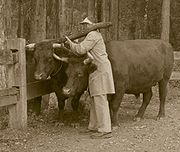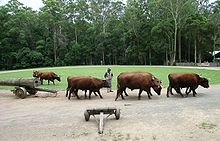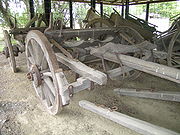
Bullocky
Encyclopedia


Australian English
Australian English is the name given to the group of dialects spoken in Australia that form a major variety of the English language....
term for the driver of a bullock team.
Bullock cart
A bullock cart or ox cart is a two-wheeled vehicle pulled by oxen . It is a means of transportation used since ancient times in many parts of the world. They are still used today where modern vehicles are too expensive or the infrastructure does not favor them.Used especially for carrying goods,...
Bullock drivers were also known as teamster
Teamster
A teamster, in modern American English, is a truck driver. The trade union named after them is the International Brotherhood of Teamsters , one of the largest unions in the United States....
s or carriers. The American term for a bullocky is a bullwhacker.
History
Bullock teams were in use in Sydney, New South Wales in 1795 when they were used for hauling building materials. The early explorers, Hume and HovellHume and Hovell expedition
The Hume and Hovell expedition was one of the most important journeys of explorations undertaken in eastern Australia. In 1824 the Governor of New South Wales, Sir Thomas Brisbane, commissioned Hamilton Hume and former Royal Navy Captain William Hovell to lead an expedition to find new grazing land...
in 1824 and Charles Sturt
Charles Sturt
Captain Charles Napier Sturt was an English explorer of Australia, and part of the European Exploration of Australia. He led several expeditions into the interior of the continent, starting from both Sydney and later from Adelaide. His expeditions traced several of the westward-flowing rivers,...
, later in 1828-9, also used bullock teams during their explorations.
Prior to the gold rush
Gold rush
A gold rush is a period of feverish migration of workers to an area that has had a dramatic discovery of gold. Major gold rushes took place in the 19th century in Australia, Brazil, Canada, South Africa, and the United States, while smaller gold rushes took place elsewhere.In the 19th and early...
es in Australia, in the mid 19th century, bullock drays carried essential food and station supplies to isolated country areas. On return trips they transported wheat
Wheat
Wheat is a cereal grain, originally from the Levant region of the Near East, but now cultivated worldwide. In 2007 world production of wheat was 607 million tons, making it the third most-produced cereal after maize and rice...
, wool
Wool
Wool is the textile fiber obtained from sheep and certain other animals, including cashmere from goats, mohair from goats, qiviut from muskoxen, vicuña, alpaca, camel from animals in the camel family, and angora from rabbits....
, sugar cane and timber by drays drawn by teams of draught animals (either bullocks
Ox
An ox , also known as a bullock in Australia, New Zealand and India, is a bovine trained as a draft animal. Oxen are commonly castrated adult male cattle; castration makes the animals more tractable...
or horse
Horse
The horse is one of two extant subspecies of Equus ferus, or the wild horse. It is a single-hooved mammal belonging to the taxonomic family Equidae. The horse has evolved over the past 45 to 55 million years from a small multi-toed creature into the large, single-toed animal of today...
s) to shipping ports before the advent of rail. They travelled constantly across the landscape, servicing the pastoral stations
Station (Australian agriculture)
Station is the term for a large Australian landholding used for livestock production. It corresponds to the North American term ranch or South American estancia...
and settlements a long way from regional transport hubs and urban centres. Some of the larger stations maintained their own teams for local use when harvesting and transporting wool. Both bullock and horse wagons carried heavy loads of wool and wheat which was the main produce transported over long distances, plus chaff and hay. A bullock wagon could only travel approximately three miles an hour (depending on the load and terrain) therefore it was slower than a horse team.
Bullock drivers were typically skilled, tough men who often faced extreme difficulties during the execution of their occupation. Bullockies were also colourful characters, often noted for their strong language. Some did not swear though, relying solely on gesture, talking and whip movements as persuasion for the team’s job at hand. A typical bullocky wore a cabbage tree hat, a twill shirt of that period, moleskin
Moleskin
Moleskin, originally referring to the short, silky fur of a mole, is heavy cotton fabric, woven and then sheared to create a short soft pile on one side. The word is also used for clothing made from this fabric, as well as adhesive pads stuck to the skin to prevent blisters.Clothing made from...
trousers, blucher boots and carried a long bullock whip which in many instances he had made.
During the early years the bullock tracks were very rough with narrow, steep “pinches”, plus dangerous river and creek crossings. Many roads still follow the tracks made by bullock teams as they negotiated their way up or down hills via a winding course to make haulage easier.
Equipment and method
Bullocks were less excitable and more dependable when faced with difficulties than horses. Furthermore, bullocks were cheaper to purchase, equip and feed. Horses also required complex, expensive leather harness that frequently needed repair. Bullock gear was simple and the yokes were sometimes made by the bullocky from different kinds of timber.
A bullocky walked on the nearside (left) of the bullocks for added control of the team and also because seating was not usually provided on the wagons and jinkers. The bullocky called each bullock by name to adjust its pace and effort. If the whip was needed it was flicked out in front of the bullock driver; then by the use of all his strength he swung it over his head, often twirling it several times before he cracked it or let fall upon the back of a bullock he might wish to reach. Sometimes the bullocky had an “offsider” (a type of an apprentice) who walked on the offside (right) of the team and also assisted the bullocky yoke up and care for the team. Many Australians who have never had contact with bullocky or a team still use the word “offsider’ as a synonym for an assistant, helper or learner.
A bullock whip had a stick handle that was cut from a spotted gum or another native tree and was approximately six or seven feet long. The long handled whip permitted the bullocky to control his bullocks while keeping a safe working distance from the danger of being run down by a large dray or jinker. The thong, often made of plaited greenhide, was 8 to 10 feet long and attached to the handle by a leather loop. These thongs, graduated in thickness from the handle down to the size of a lead pencil at the fall, which was about 2 ½ feet long. The bullockies often didn't use a cracker, but if they did it was knotted into the end of the fall.

Toona ciliata
Australian Red Cedar , Toona ciliata is a forest tree in the family Meliaceae which grows throughout southern Asia from Afghanistan to Papua New Guinea and Australia. In Australia its natural habitat is now extensively cleared subtropical rainforests of New South Wales and Queensland...
), and other logs to sawmills or to a river for further transport.
On steep hills bullock teams often required additional assistance to negotiate these inclines. This assistance was provided by hitching two or more teams together for the ascent. On steep descents logs or trees were dragged behind the dray, wagon or jinker to slow the load's descent and protect the team from injury. Shanties and villages grew to serve the needs of the road's users at the site of difficult range and river crossings where teams met.
Bullock teams were still used to drag logs from the forests to log dumps after the introduction of logging trucks. Nowadays they are mainly used for exhibition purposes.
Early references
The following reference is from the newspaper The Australasian of 17 July 1869 (page 17): “Cornstalk and gumsucker are both of colonial growth, and so, I think, is… bullocky (a teamster)”.Percy Clarke’s ‘New Chum’ in Australia (1886) has the following reference (page 137): “I knew a ‘bullockie’ (as these men are dubbed) who had a team of twelve beasts under his command which obeyed his every word and never received a word, which a ‘high-born ladie’ might not have listened to”.

